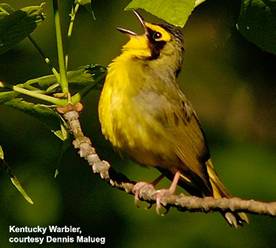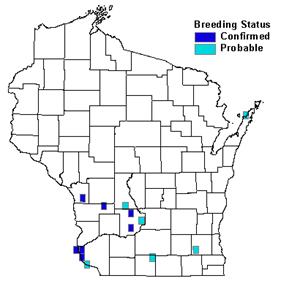Photo by Dennis Malueg


Status/Protection
- Global Rank: G5 Key to global and state ranks
- State Rank: S1S2B
- WBCI Priority: SGCN, State Threatened
Population Information
Federal BBS information can be obtained at http://www.mbr-pwrc.usgs.gov/bbs/bbs.html by clicking on Trend Estimates and selecting the species in question. All estimates are for 1966-2005.
- Federal Breeding Bird Survey: significant decline
- Federal Breeding Bird Survey (WI): N/A
- Federal Breeding Bird Survey (BCR 23): N/A
- Federal Breeding Bird Survey (BCR 12): N/A
- WSO Checklist Project: stable (1983-2007)
Life History
- Breeding Range: Atlantic Coast west to the Great Plains (McDonald 1998).
- Breeding Habitat: Bottomland Hardwoods, Northern Hardwood, Central Hardwood, Oak, riparian woodlands with dense understory vegetation.
- Nest: On or very near ground; open cup woven from coarse grasses.
- Nesting Dates: Eggs: mid-June in Wisconsin (Robbins 1991); mid-May to early July elsewhere in range (McDonald 1998).
- Foraging: Ground feeder, gleaning and hawking in lower foliage (Ehrlich et al. 1988).
- Migrant Status: Neotropical migrant.
- Habitat use during Migration: Not well known; assumed similar to breeding habitat.
- Arrival Dates: Early to late May (Robbins 1991).
- Departure Dates: Mid-August to mid-September (Robbins 1991).
- Winter Range: Mexico through Central America into Colombia and Venezuela, and the Caribbean.
- Winter Habitat: Both second-growth and mature moist, tropical lowland forests.
Habitat Selection
The Kentucky Warbler inhabits bottomland hardwoods and riparian woodlands with a dense understory (McDonald 1998). In Wisconsin, it occurs in southern upland hardwood forests comprised of sugar maple, basswood, and beech trees (Cutright 2006) and heavily wooded bottomlands (Robbins 1991). Here it is found most commonly along ravines and hillsides associated with smaller tributary streams. In the Baraboo Hills, Mossman and Lange (1982) found it in shrubby openings and forest edges. Edges, however, are less preferred than forest interiors throughout its range (McDonald 1998). Riparian width and overall patch size are important factors in habitat selection. Peak and Thompson (2006) found higher densities of Kentucky Warblers in wide (400-530 m) forested-riparian areas compared to narrow (55-95 m) forested-riparian areas of northeastern Missouri. Minimum patch size requirements in Wisconsin are not well-studied.
Although it is often considered an area-sensitive, forest-interior species, the Kentucky Warbler will nest in a variety of forest types as long as a dense ground-layer is present (Morse and Robinson 1999). Nests are placed on the ground, typically well concealed under low shrubbery, and sites may be used annually by the same individuals (Wetmore et al. 1984, McDonald 1998).
Habitat Availability
Wisconsin is on the extreme northern edge of the range of the Kentucky Warbler (McDonald 1998). It occurs throughout much of the Wisconsin River drainage system in southwest Wisconsin (Mossman and Lange 1982) with breeding confirmed in Grant, Sauk, Vernon, and La Crosse counties (Cutright 2006). Loss and fragmentation of forests south of the tension zone has reduced the amount of suitable habitat available for this species. Invasive plant species may be impacting remnants of suitable habitat by inhibiting regeneration (WDNR 2005).
Population Concerns
Breeding Bird Survey data suggest a significant annual decline range-wide for this species (Sauer et al. 2005). Population trends in Wisconsin are unknown because of the Kentucky Warbler’s rarity in the state. This species is rarely recorded on either the Wisconsin Breeding Bird Surveys or the Wisconsin Checklist Project (Temple et al. 1997, Sauer et al. 2005). Thus, intensive, targeted survey efforts will be necessary to obtain better population data. Wisconsin Breeding Bird Atlas observers confirmed breeding on less than 1% of the surveyed quads (Cutright 2006).
Several factors may contribute to the vulnerability of the state’s Kentucky Warbler population. Wisconsin is far from the Kentucky Warbler’s core distribution and population, thus it is unlikely to ever be common in southern Wisconsin. Forest fragmentation and subsequent Brown-headed Cowbird parasitism are significant concerns. Robinson et al. (1995) found that highly fragmented forests in five Midwestern states were population sinks because of high levels of Brown-headed Cowbird parasitism. Forest fragmentation and the increasing number of housing developments in Wisconsin woodlands also may increase exposure of this ground-nesting warbler to nest predators, particularly cats. Finally, deforestation on the wintering grounds, particularly in regions with mature forests, also is a concern (McDonald 1998).
Recommended Management
Management efforts for this species should focus on reducing forest fragmentation in the southwestern counties and along the major river systems of southern Wisconsin. Managers should consider leaving core areas of mature forest far (>1 km) from potential Brown-headed Cowbird foraging sites to improve nesting success for Kentucky Warblers and other forest-interior species (Morse and Robinson 1999). Furthermore, managers should retain forested-riparian areas 400 m in width, and when possible, increase the width of all forested-riparian areas. The addition of grassland-shrub buffer strips adjacent to forested-riparian areas may be one tool to increase riparian width (Peak and Thompson 2006). Because overbrowsing by white-tailed deer may eliminate forest understory and degrade otherwise suitable habitat for Kentucky Warblers (Robbins et al. 1986), managers may need to consider reducing deer densities in designated conservation areas for this species. Kentucky Warblers are tolerant of selective logging practices, as long as a dense understory and abundant shrubs are allowed to develop (McDonald 1998, Robinson and Robinson 2001).
Conservation and management strategies for this species should be focused in the following ecological landscapes: Southeast Glacial Plains and Western Coulee and Ridges (WDNR 2005). Within these landscapes, key conservation sites include Wyalusing Park State Natural Area and the Baraboo Hills region (Mossman and Hoffman 1989).
Research Needs
More information is needed on the distribution and population trend of this species in Wisconsin. Long-term monitoring of the Kentucky Warbler should be focused in southwest Wisconsin, along the Wisconsin River, and in the Baraboo Hills. More research on breeding habitat requirements, including minimum area requirements, would help future management efforts. Habitat use during migration also needs more study. Finally, much biological and ecological information is needed from wintering sites (McDonald 1998).
Information Sources
- Birds of Forested Landscapes, Cornell Lab of Ornithology: http://www.birds.cornell.edu/bfl/speciesaccts/kenwar.html
- Patuxent Bird Identification Center: http://www.mbr-pwrc.usgs.gov/id/framlst/i6770id.html
- North American Breeding Bird Survey: http://www.mbr-pwrc.usgs.gov/bbs/bbs.html
- Temple S.A., J.R. Cary, and R. Rolley. 1997. Wisconsin Birds: A Seasonal and Geographical Guide. Wisconsin Society of Ornithology and Wisconsin Department of Natural Resources, Madison, WI.
- Wisconsin Breeding Bird Atlas: http://www.uwgb.edu/birds/wbba/
References
- Cutright, N.J. 2006. Kentucky Warbler. In Atlas of the Breeding Birds of Wisconsin. (N.J. Cutright, B.R. Harriman, and R.W. Howe, eds.) The Wisconsin Society for Ornithology, Inc. 602pp.
- Ehrlich, P.R., D.S. Dobkin, and D. Wheye. 1988. The birders handbook: a field guide to the natural history of North American birds. Simon & Schuster, Inc. New York.
- McDonald, M.V. 1998. Kentucky Warbler. In The Birds of North America, No. 324 (A. Poole and F. Gill, eds.). The Birds of North America, Inc., Philadelphia, PA.
- Morse, S.F. and S.K. Robinson. 1999. Nesting success of a Neotropical migrant in a multiple-use, forest lands. Cons. Biol. 13(2): 327-337.
- Mossman, M.J. and K.I. Lange. 1982. Breeding birds of the Baraboo Hills, Wisconsin: Their history, distribution and ecology. Wis. Dep. Nat. Resour. and Wis. Soc. Ornithol., Madison.
- Mossman, M.J., and R.M. Hoffman. 1989. Birds of southern Wisconsin upland forests. Passenger Pigeon 51: 343-358.
- Peak, R.G. and F.A Thompson III. 2006. Factors Affecting Avian Species Richness and Density in Riparian Areas. Journal of Wildlife Management 70(1): 173-179.
- Robbins, C.S., D. Bystrak, and P.H. Geissler. 1986. The breeding bird survey: its first fifteen years, 1965-1979. U.S. Dept. of the Interior, Fish and Wildlife Service, Res. Publ. 157, Washington, D.C.
- Robbins, S.D., Jr. 1991. Wisconsin birdlife: Population and distribution past and present. Madison, WI: Univ. Wisconsin Press.
- Robinson, S.K., F.R. Thompson III, T.M. Donovan, D.R. Whitehead, and J. Faaborg. 1995. Regional forest fragmentation and the nesting success of migratory birds. Science 267: 1987-1990.
- Robinson, S.K. and W.D. Robinson. 2001. Avian nesting success in a selectively harvested north temperate deciduous forest. Conservation Biology 15(6): 1763-1771.
- Sauer, J.R., J.E. Hines, and J. Fallon. 2005. The North American Breeding Bird Survey, Results and Analysis 1966 - 2005. Version 6.2.2006. USGS Patuxent Wildlife Research Center, Laurel, MD.
- Temple S.A., J.R. Cary, and R. Rolley. 1997. Wisconsin Birds: A Seasonal and Geographical Guide. Wisconsin Society of Ornithology and Wisconsin Department of Natural Resources, Madison, WI.
- Wetmore, A., R. F. Pasquier, and S. L. Olson. 1984. The birds of the Republic of Panama. Part 4. Smithson. Misc. Coll. 150.
- Wisconsin Department of Natural Resources (WDNR). 2005. Wisconsin’s Strategy for Wildlife Species of Greatest Conservation Need. Madison, WI.
Contact Information
- Compiler: Tom Klubertanz, tklubert@uwc.edu
- Editor: Kim Kreitinger, K.Kreitinger@gmail.com
